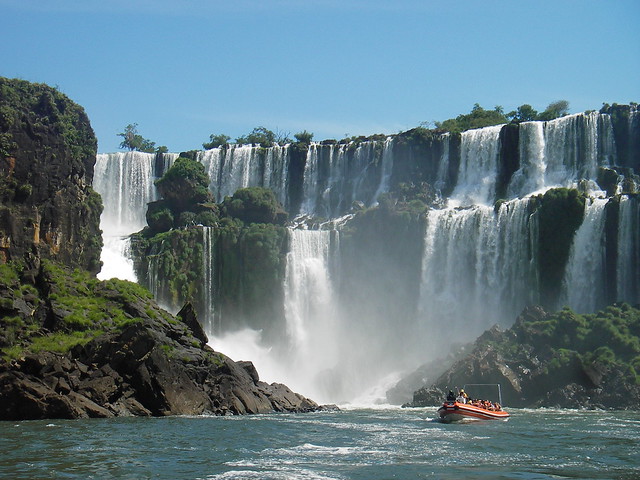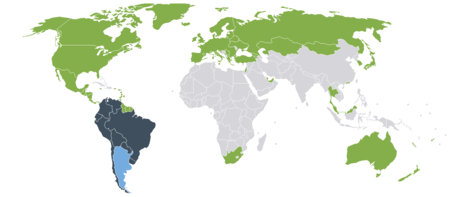
Argentina

A country in South AmericaThe Republic of Argentina is a country located in South America between 34 ° 36 ‘South latitudes and 58 ° 27’ Western longitudes. The total area of Argentina 2.79181 million square kilometers – about 3.5 times larger than Turkey, while its population is 36,260,130 people with the 2001 census figures. Argentina in the southern part of the South American continent, the Andes and the Atlantic Oceanis a state that extends between; the length of the coastline is 4989 km. The land owned by Argentina is the second largest in the South America and the 8th in the world. There are borders with Chile, Bolivia, Paraguay, Brazil and Uruguay. The name of Argentina comes from the Latin word ‘Argentum’. The name of the country, which the Spanish colonists hope to find in this land, can be clearly understood. Most of the inhabitants of the country are descendants of Spanish and Italian immigrants.
Other popular destinations for Argentina
Capital of ArgentinaBuenos Aires is the capital of Argentina and the second largest city in South America after São Paulo. Buenos Aires, which is the largest city in Argentina, is also one of the largest cities in South America. According to the 2001 census, there are 2,776,234 people living in the city, but this number exceeds 12 million when the surrounding suburbs are taken into account. Although the majority of the inhabitants of the city are of Spanish and Italian origin, there are also Arab, Jewish, Georgian, Armenian, Chinese and Korean descent. The most common religion is Catholic Christianity and the official language is Spanish.
Torres Del Paine National ParkNational
ParkVery wide national park offering mountain and glacier landscapes, over 100 bird species, camping and boat rides.
Ushuaia
A city in Argentina,
Ushuaia is the southernmost city of Argentina. With a few other cities, the most southern city in the world is in dispute for the title. In fact, even though there are settlements in the south of Ushuaia, they are military bases and they do not have a civilian population. It is the capital of the province of Argentina, Tierra del Fuego. It is located on the south bank of the Fire Territory , on the banks of the Beagle Canal. Ushuaia, the former owners of the region means the bay facing the East in the Yámana language. According to another claim, Ushuaia means that you put your face in the sun. However, this claim does not seem to make sense because of the opening of Ushuaia Bay to the southeast.
Perito Moreno Glacier
A glacier in Argentina,
Perito Moreno Glacier is an extension of the Campo de Hielo Sur glacier region of Patagonia, just 1500 m above sea level, southwest of Argentina. He takes his name from Francisco Pascasio Moreno, a researcher in Patagonia. The closest major settlement is El Calafate, 80 km away, and this is the ideal exit of the ice-made tours through the shaft park.is the point. The Glacier is one of the major sights of Los Glaciares National Park and all of Argentina. Perito Moreno is one of the few known glaciers, except Antarctica and Greenland. The reason for this is that the clouds coming from the Great Ocean leave very strong rainfall to the Andes. 60 km of ice mass is about 1 m per day. This is characterized by continuous cracking and breaking noise in the massive mass. On a regular basis, large pieces break at the front façade of about 60 m in height and 5 km in width. This situation leads to the fluffy waves in the lake. Due to the continuous drift, the glacier blocks Lago Argentino’s side arm Brazo Rico every four years. Thus, the water level in this branch of the southern part fed by rivers quickly increases. Wikipedia
Mendoza
A city in Argentina,
Mendoza is the center of the province with the same name to the west of Argentina. Mendoza, where 111,000 people live, is the country’s fourth largest metropolitan area with a population of 848,660. Major industries include winemaking and olive oil production. Wikipedia
Los Glaciares National Park
A national park in Argentina
is a national park in the Province of Santa Cruz in the Patagonia region of Argentina. It covers an area of 726,927 hectares. It is the second largest national park in Argentina. Founded on 11 May 1937, the park has magellanic subpolar forests and biodiversity of the Patagonia steppes. World Heritage List by UNESCO in 1981It was obtained. The name of the park, which has 13 glaciers flowing into the Atlantic Ocean, fed by 47 large glaciers in the Andes Mountains, means the giant ice container. It is the largest ice cover outside of Antarctica and Greenland. In other parts of the world, glaciers start on average at least 2500 m above sea level, but due to the size of the ice cover, these glaciers start at 1500 meters, after 200 meters down, they are based on the border of Los Glaciares National Park and are located in the Chilean territory of Torres del Paine National Park. it reaches.
Iguazú National Park
A national park in Argentina
Spacious park with a visitor center that can be reached by train from the huge Iguazú Waterfall.
Valdés Peninsula
A peninsula in Argentina
A peninsula of approximately 3625 km² in the Valdés Peninsula, Argentina. It is on the Atlantic Ocean coast in Chubut Province. The peninsula is a natural conservation zone and was declared a UNESCO World Heritage Site in 1999. A large part of Valdes consists of a modest nature and a few small salt lakes. The largest of these is sea levelIt is 35 m below and is the lowest point in Argentina. The special meaning of the peninsula is the marine mammals lurking on their beaches. These are sea lions and sea elephants. The Southern Whales are found in the Golfo Nuevo, which is formed by the peninsula and the mainland of the Patagonia mainland. This barred whale species comes here to breed in the second half of the year because the water of the bay is calmer and warmer than the water of the open sea. Killer whales live in the open sea, in front of the peninsula. In the inner parts of the peninsula before the ostrich-like nandular, guakos, maras comes to mind. The village of Puerto Pirámide is the only settlement on the Valdes Peninsula. Until a few years ago, the Argentine army had bases on the peninsula. Today there are still remains of a flight track in Punta Norte. Wikipedia
Villa La Angostura
Villa La Angostura is a town located in the Los Lagos Department in the south of the Argentine province of Neuquén, on the northwest shore of the Nahuel Huapi Lake. Wikipedia
Iberá Wetlands
The Iberá Wetlands are a mix of swamps, bogs, stagnant lakes, lagoons, natural slough and courses of water in the center and center-north of the province of Corrientes, Argentina. Wikipedia
Parque Nacional Nahuel Huapi
Nahuel Huapi National Park is the oldest national park in Argentina, established in 1934. It surrounds Nahuel Huapi Lake in the foothills of the Patagonian Andes. The largest of the national parks in the region, it has an area of 7,050 km², or nearly 2 million acres.
Things to do
Perito Moreno Glacier
A national park in Argentina
Los Glaciares National Park is a national park in the Province of Santa Cruz in the Patagonia region of Argentina. It covers an area of 726,927 hectares. It is the second largest national park in Argentina. Wikipedia
Los Glaciares National Park
Glacier and park
Los Glaciares National Park is a national park in the Province of Santa Cruz in the Patagonia region of Argentina. It covers an area of 726,927 hectares. It is the second largest national park in Argentina. Wikipedia
Aconcagua
Mountain, climbing, glacier, native vine and camping
Aconcagua is the highest mountain in South America with a height of 6,962,97 m. It is also the highest mountain outside Asia. It is located in the Argentine Andes, in the province of Mendoza, near the Chilean border. It has 5 glaciers that extend up to ten kilometers. It is unclear where his name came from. Wikipedia
Iguazú National Park
Waterfall walk path in national park
Iguazú National Park is a national park located in the Iguazú department in the north of Misiones Province in Mesopotamia. It covers an area of 672 km². It is located on the Iguazu River, opposite its brother in Brazil. Both regions were declared World Heritage by UNESCO in 1984. Wikipedia
Plaza de Mayo
Iconic 19th Century City Square
Plaza de Mayo is the famous square of Argentina’s capital, Buenos Aires. It is the starting square of the 8-year rule of the Argentine junta, where the independence of the country was declared. Wikipedia
Teatro Colón
Theater, opera, acoustic, ballet and tango
Teatro Colón is the main opera hall in the capital of Argentina, Buenos Aires. According to National Geographic, it is the third best concert hall in the world and is considered among the top five concert halls in the world acoustically. acoustic experts Leo Beranek international opera and orchestra … Wikipedia
Obelisk of Buenos Aires
67 m iconic white obelisk
The Obelisk of Buenos Aires is an obelisk located in Buenos Aires, the capital of Argentina. The monument was built in May 1936 to commemorate the 400th anniversary of the city’s founding. Located in the center of Plaza de la República, the total height of the monument is 67 meters and the monument covers an area of 49 square meters. Wikipedia
Parque Nacional Nahuel Huapi
Glacier
Nahuel Huapi National Park, in Argentina, was founded in 1934, it is the oldest national park. It is surrounded by Nahuel Huapi Lake at the foot of the Patagonia Andes. It is the largest of the national parks in the region with an area of 7.050 km² or approximately 2 million acres.
Ischigualasto National Park
Fossil and nature
Ischigualasto State Park, Ischigualasto City Park, also known as Valle de la Luna, is located in the Province of San Juan in northwestern Argentina
Museo Nacional de Bellas Artes
Museum, art, Auguste Rodin, painting and sculpture
Beleo Artes Museum, located in the city’s Recoleta is an Argentine art museum in Buenos Aires. The museum opened a branch in Neuquén in 2004. Wikipedia
Jardín Japonés
Garden, planetarium and park
Buenos Aires Japanese Gardens, a nonprofit in Buenos Aires in Argentina is a non-profit public space managed by the Japanese Argentine Cultural Foundation and is one of the largest Japanese garden of its kind in the world outside Japan. Wikipedia
El Ateneo Grand Splendid
Theater and architecture
El Ateneo Grand Splendid, Buenos Aires in Argentina in a bookstore. In 2008, The Guardian became the second most beautiful bookstore in the world. In 2019 he was named “The most beautiful bookstore in the world” by National Geographic. Wikipedia
MALBA
Art museum, Frida Kahlo, painting and museum
Buenos Aires Latin American Art Museum in Buenos Aires’s Palermo, Figueroa Alcorta is a museum located on the Boulevard. The museum, created by the Argentine businessman Eduardo Costantini, is run by the non-profit Fundación MALBA – Costantini and opened on September 21, 2001. Wikipedia
Jardín Botánico Carlos Thays
A botanical garden in Buenos Aires, Argentina
Buenos Aires Botanical Garden, it is a botanical garden located in the Palermo district of Buenos Aires in Argentina. The garden shape is triangular and is limited to Santa Fe Boulevard, Las Heras Avenue and República Árabe Siria Avenue. Wikipedia
Reserva Ecológica Costanera Sur
Nature conservation area, bird watching and history
Buenos Aires Ecological Reserve, Reserva Ecológica de Buenos Aires, Costanera Sur is also known as the Ecological Protection Area, Reserva Ecológica Costanera Sur, located in the eastern side of Puerto district of Río de la Plata river is a low land 865 acres on the shores of Buenos Aires CBD, Madero in Argentina. Wikipedia
Get in
Visas

Passport holders of the following countries do not need a visa to enter Argentina when the purpose of the visit is tourism for up to 90 days (unless otherwise noted): Andorra, Armenia, Australia, Austria, Barbados, Belarus, Belgium, Bolivia, Brazil, Bulgaria, Canada, Chile, Colombia, Costa Rica, Croatia, Cyprus, Czech Republic, Denmark, Ecuador, El Salvador, Estonia, Fiji, Finland, France, Georgia, Germany, Greece, Grenada, Guatemala, Guyana, Haiti, Honduras, Hong Kong, Hungary, Iceland, Ireland, Israel, Italy, Jamaica (30 days), Japan, Kazakhstan (30 days), Republic of Korea, Latvia, Liechtenstein, Lithuania, Luxembourg, Malaysia (30 days), Malta, Mexico, Monaco, Mongolia, Montenegro, Netherlands, New Zealand, Nicaragua, North Macedonia, Norway, Panama, Paraguay, Peru, Poland, Portugal, Romania, Russia, Saint Kitts and Nevis, Saint Lucia, Saint Vincent and the Grenadines, San Marino, Serbia, Singapore, Slovakia, Slovenia, South Africa, Spain, Suriname, Sweden, Switzerland, Thailand, Trinidad and Tobago, Turkey, Ukraine, United Arab Emirates, United Kingdom, United States of America, Uruguay, Vatican City and Venezuela.
Citizens and residents (if their nationality is mentioned under visa exemptions applicable to normal passport holders) of the following countries can enter with their National ID card: Bolivia, Brazil, Chile, Colombia, Ecuador, Paraguay, Peru, Uruguay and Venezuela.
Citizens of China including Macau who also hold a valid B1/B2 visa issued by the United States or a Schengen visa can obtain an Electronic Travel Authorization (AVE) at a cost of US$50 prior to travelling to Argentina. The validity of Schengen or U.S. visas must be more than 3 months. The processing time is 10 business days.
At arrival
You may bring in goods worth US$300 without paying duties.
If you are just changing planes at the same airport and not entering the country you will still be given a customs form to fill in but as of May 2014 nobody asks for it at the airport and you can keep it as a souvenir.
Respect
Argentines are very engaging people who may ask very personal questions within minutes after first meeting someone, and they would expect you to reciprocate. Failing to do so would indicate disinterest in the other person.
Don’t be offended if someone calls you a “boludo”/”boluda”. Even though it’s a swear word it also means “dude”/”buddy”/”mate”. Argentinian people are infamous for the amount of cursing they do, so if they are talking to you don’t pay attention to the cursing. If Argentinians are mad, teasing you or making fun of you, you will tell by the expression of their face or the tone of their voice as well as even more cursing than usual.
Don’t be offended if an Argentinian says things to you in a very direct manner: this is very usual among locals and sometimes offends foreigners. Argentinians are very emotional and passionate, both when telling good things or bad things to anyone.
General
Religious sites: People do not have to cover their heads when entering a church or temple; however, wearing shorts, miniskirts and sleeveless shirts, as well as close physical contact between sexes is not encouraged.
Beach: Sunbathing topless is not a common custom, although you can change cloths on the beach.


